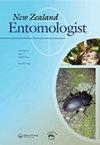Review of control options for elm leaf beetle, Xanthogaleruca luteola Müller, with a focus on Australia
IF 0.4
4区 农林科学
Q4 ENTOMOLOGY
引用次数: 1
Abstract
ABSTRACT Elm leaf beetle (ELB) is a comparatively new invader in south-eastern Australia. ELB can cause considerable defoliation and adversely impact tree health. Here, we conducted a literature review and found a range of control measures. We found two main biological control insects, Oomyzus gallerucae and Erynniopsis antennata, but they rarely adequately control ELB populations or prevent considerable defoliation. We report on more than 20 insecticides used to control ELB, primarily consisting of organophosphates, pyrethroids and neonicotinoids. There is no ideal insecticide as some very effective insecticides have environmental or human health concerns. Products based on azadirachtin or similar compounds seem to generate least concerns and are insect specific, but may have short residues. The choice of insecticidal intervention will be based on issues pertinent to each situation and many pesticide options are available.榆树叶甲虫(Xanthogaleruca luteola m ller)防治方案综述,以澳大利亚为重点
摘要:榆树叶甲(ELB)是澳大利亚东南部一种较新的入侵动物。ELB会造成大量落叶,并对树木健康产生不利影响。在这里,我们进行了文献综述,发现了一系列控制措施。我们发现了两种主要的生物控制昆虫,Oomyzus gallerucae和Eryniopsis antennata,但它们很少能充分控制ELB种群或防止大量落叶。我们报告了20多种用于控制ELB的杀虫剂,主要由有机磷、拟除虫菊酯类和新烟碱类组成。没有理想的杀虫剂,因为一些非常有效的杀虫剂会引起环境或人类健康问题。以印楝素或类似化合物为基础的产品似乎引起的关注最少,而且是昆虫特有的,但可能残留量很短。杀虫剂干预措施的选择将基于与每种情况相关的问题,并且有许多杀虫剂选择。
本文章由计算机程序翻译,如有差异,请以英文原文为准。
求助全文
约1分钟内获得全文
求助全文
来源期刊

New Zealand Entomologist
ENTOMOLOGY-
CiteScore
0.70
自引率
33.30%
发文量
3
审稿时长
>12 weeks
期刊介绍:
The invertebrate diversity of New Zealand is of great interest worldwide because of its geographic isolation and geological history. The New Zealand Entomologist plays an important role in disseminating information on field-based, experimental, and theoretical research.
The New Zealand Entomologist publishes original research papers, review papers and short communications. We welcome submissions in all aspects of science regarding insects and arthropods in a New Zealand or Australasian setting. The journal’s subject matter encompasses taxonomy, phylogenetics, biogeography, biological control and pest management, conservation, ecology and natural history.
The journal is the official publication of the Entomological Society of New Zealand. Papers published or submitted elsewhere for publication will not be considered, but publication of an abstract or summary elsewhere (e.g. conference proceedings) does not preclude full publication in the New Zealand Entomologist. Accepted papers become copyright of the Entomological Society of New Zealand. The journal is published in English, but we also welcome publication of abstracts in Maori.
 求助内容:
求助内容: 应助结果提醒方式:
应助结果提醒方式:


